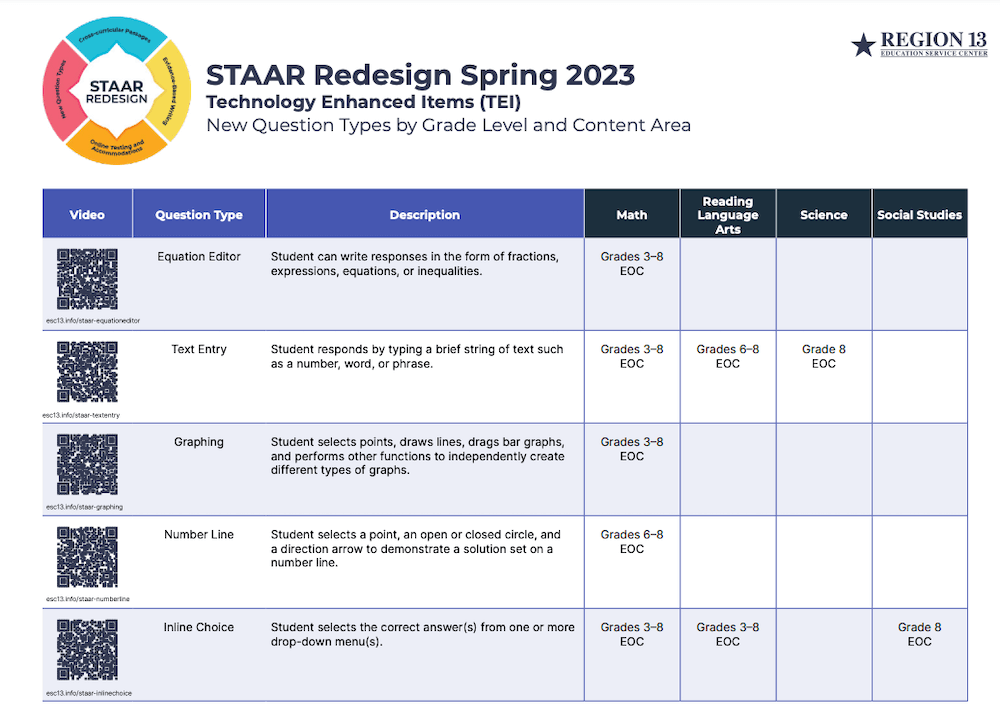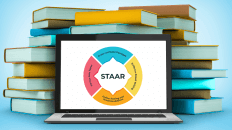As a result of House Bill (HB) 3906, passed by the 86th Texas Legislature in 2019, the STAAR tests are undergoing a major redesign that will affect how students are assessed on the summative assessment. This redesign should align the STAAR test with instructional best practices that teachers are using in their classrooms.
It should be noted that the STAAR tests are not being redesigned because they are flawed. A 2016 analysis determined that the STAAR tests were valid and reliable, finding that the “test bears a strong association with on-grade curriculum requirements”. The current STAAR tests are also aligned and readable. A 2019 analysis found that, across grade levels and subjects, all tests included in the study were aligned with the TEKS for the grade level tested and that 91% of the passages met the criterion for readability as defined by the study.
So if the STAAR tests are valid, reliable, aligned, and readable why are they being redesigned? HB 3906 puts in place several requirements that are meant to make the STAAR test design more closely resemble instructional best practices, and TEA is using the opportunity to incorporate other best practices as well.
It should be remembered that the STAAR tests are summative assessments and just a part of a well-balanced assessment program. They determine mastery of a breadth of knowledge and skills and the effectiveness of curriculum and instructional programs after delivery. They help determine individual student needs for additional holistic support. They serve as a bar for rigor and standards alignment in planning. TEA provides other types of assessments [Diagnostic (Beginning-of-Year), Formative (Texas Formative Assessment Resource or TFAR), and Interim (STAAR Interim Assessments)] to measure other aspects of student performance.
Implications of the STAAR redesign
The near-term implications of the STAAR redesign include 4 aspects: cross-curricular item types, writing, new item types, and online assessments.
Cross-curricular items
Cross-curricular passages reference topics that students have learned about in subject areas other than reading language arts (RLA) and allow them to use their background knowledge and vocabulary to understand the passage. The items for the passage will still assess RLA TEKS, just the topic of the passage will relate to information learned in other curriculum areas. The percentage of cross-curricular passages on STAAR RLA tests has been increasing over the past several years with the goal of having 100% of the informational passages on the STAAR 3-8 RLA tests be cross-curricular by the 2023-2024 school year.
Writing
As everyone should know by now, the stand-alone STAAR writing tests have been discontinued. However, the Every Student Succeeds Act (ESSA) requires states to assess the breadth of their curriculum and in Texas the RLA TEKS include writing. Therefore the redesigned STAAR 3-8 RLA tests will include items to assess writing.
New items
STAAR 3-8 RLA tests in May 2022 will include embedded multiple-choice editing and revising field test items (these embedded field-test items were also found on the test administered in May 2021). These items will not be included in the student’s STAAR results. In May 2023 the revising and editing items will be operational and included in the student’s STAAR results.
The February 2022 Stand-Alone Field Tests for 3-8 RLA included extended constructed response items, however, the May 2022 3-8 STAAR RLA tests will not include any extended constructed response item types. In the past students were given a prompt (example: Think of a gift you would like to receive and tell why you want that item) and asked to respond to it. These types of prompts are very hard to create without having a bias towards some students (in the example above, if a student has never received a gift it may be hard for them to imagine receiving one). Future writing prompts will be based on a passage that the student has already read to answer previous questions and will require the student to use information from the passage to support their answer (example: Read the play “The Spelling Test”. Based on the information in the play, write a response to the following: “Explain how Herbie’s behavior changes and how this is developed by the playwright.”).
In the classroom, students are asked to engage with the content in multiple ways and are provided multiple open-ended formats to respond to questions. A strict multiple choice test does not allow this interaction. The new, non-multiple choice item types currently under consideration, and on the February Stand-Alone Field Tests are more like the questions teachers ask in class. TEA has released several resources to help teachers to understand the new item types being considered and to provide students with practice interacting with the items.

A matrix has been developed that lists all of the new item types being considered, a description of the item type, and the STAAR tests for which the item type is being considered. Exactly which item types will be used on which STAAR tests will be decided once data from the February 2022 Stand-Alone Field Tests have been analyzed.
Online Assessment
Online samplers of the new question types have been released in the Practice and Released Online Tests site (this site best viewed from desktop computer). Using the above link anyone may log in to this site by leaving the Guest User and Guest Session toggles set to “ON” and clicking the green “Sign In” button. The next screen allows the user to select a grade level, any grade level selected (except “2”) will bring up the 2021 STAAR New Item Types (in green) for any tested subject at that grade level. In addition, you can scroll down and find the 2020 STAAR Revising and Editing Practice Set (in blue) for the grade level at the very bottom of the test selections. Once all of the items in the sampler have been completed the test taker will see a list of the item numbers and the number of points they received for each response. You can look at the Sampler Item Key for the grade level/subject to see the correct answer and the maximum number of points each item is worth.
More detailed information on the new item types is contained in the Accompanying Guides to New Question Type Samplers. The Guides provide the question types that may be included on STAAR tests of that subject starting in Spring 2023, a description of the question type, the grade levels that may see that questions type, and the possible point value for the question. The guides provide details on how the item responses may be reported in the STAAR results data files as well as examples of what the student will see when the question first appears and after they have selected their response. Details for at least two examples of each question type are provided.
- Math Accompanying Guide
- RLA Accompanying Guide
- Science Accompanying Guide
- Social Studies Accompanying Guide
- Spanish RLA Accompanying Guide
Blueprints and calendars
With the addition of the new test items, other changes are necessary. The assessed curriculums for STAAR RLA tests are, as of spring 2022, based solely on the 2017 TEKS. In addition, the writing TEKS have been added to the RLA assessed curriculum documents. With the new test questions, the test blueprints for each STAAR test have been preliminarily updated to reflect what Student Assessment believes the new tests to look like (final decisions will be made once the Stand-Alone Field Test data is analyzed). STAAR Alternate 2 RLA blueprints have been updated to reflect the inclusion of writing items on those tests so that they continue to mirror their general STAAR assessment counterparts. The new assessed curriculums and preliminary spring 2022 STAAR blueprints can be found here.
With the addition of extended constructed response items on the STAAR RLA tests it also becomes necessary to revamp the Student Assessment Testing Calendar. The new 2022-2023 Testing Calendar reflects a new approach to test scheduling. STAAR tests are combined by subject to form testing windows without regard to grade level (for example, all STAAR RLA tests, 3-8 and English I & II, have the same testing window). This approach allows tests that need a human eye for scoring to be administered first.
Accommodations
During instruction teachers support the learning of all students through appropriate accommodations. Moving to 100% online assessments will ensure that all students have a full suite of robust accommodations to meet their specific learning needs. Texas is well on the way to meeting this goal. December online testing increased from 44% in December 2019 to 87% in December 2021. Online testing benefits include ease of accessibility allocation, fewer errors in delivering accommodations, standardization of accommodations across campuses and districts, and faster delivery of test results. Student Assessment offers several ways for students to practice online testing using the same interface as the STAAR tests, including the Online Released and Practice Tests, Interim STAAR Assessments, and TFAR.
The requirement to administer 100% of STAAR tests online begins with the December 2022 STAAR administration. STAAR Alternate 2 is not included in this requirement. Student Assessment also realizes that there will always be a small percentage of students who will require paper testing due to individual circumstances. TEA Student Assessment has outlined criteria for determining which students may qualify for a special administration of an online test. Local districts will use these criteria to determine which students should take a paper STAAR test.
Through-Year Assessments
Texas is exploring the development of through-year assessments to replace the end-of-year STAAR tests. Benefits of a through-year summative assessment model include more timely and frequent feedback, multiple opportunities for students to demonstrate proficiency, possibly being able to calculate growth through the year, and creating a more cohesive assessment system by replacing interim assessments. The through-year assessment could be administered 3 times a year, with the entire curriculum assessed each time (to allow for multiple opportunities to show proficiency on the TEKS and to allow for growth to be calculated after administrations 2 and 3). The test would be online and could be multi-stage adaptive (to allow for faster turn-around of results and shorter and more accurate assessments). Scoring features could include a help-not-hurt model where the higher of the student’s third administration score or a weighted average from all three administrations is used. An optional pilot is being conducted during the 2022-2023 school year. Participants in the pilot will receive interim feedback including the through-year growth data, increased familiarity with the new STAAR questions types and testing platform, training to help educators understand the data, and helping to shape the future of Texas assessment. Challenges to participating in the pilot include not receiving cumulative scores for students until the fall of the next school year (fall 2023) and the fact that students would still be required to participate in all required 2022-2023 STAAR testing. Additional districts will be invited to submit requests to be included in the pilot during the 2023-2024 school year.
Visit our STAAR Redesign Blueprint Comparisons and Response Rubrics website https://esc13.net/resources/staar-redesign-blueprint-comparisons-response-rubrics
Butch has worked with testing and accountability for over 15 years at the campus, district, regional, and state levels. Originally from North Carolina, Butch is the State Assessment Specialist for the Education Service Center Region 13, helping district test coordinators and others navigate the world of STAAR and TELPAS testing. He is available to answer any of your state testing policy and procedure questions.






Add comment